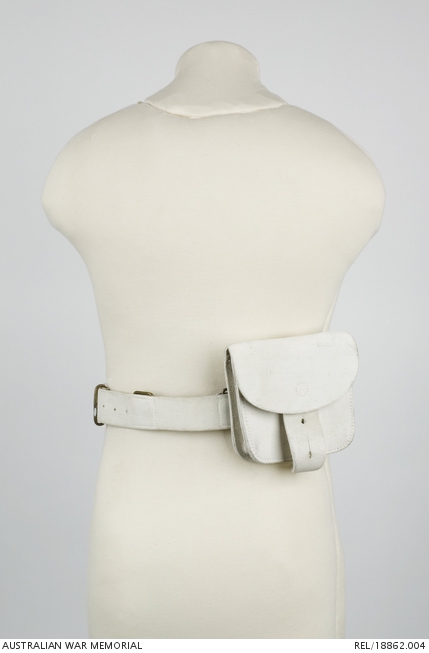| Place | Oceania: Australia, New South Wales, Sydney |
|---|---|
| Accession Number | REL/18862.004 |
| Collection type | Heraldry |
| Object type | Personal Equipment |
| Physical description | Brass, Buff leather |
| Maker |
Unknown |
| Date made | c 1882-1888 |
| Conflict |
Australian Colonial Forces, 1854-1900 |
Other Ranks 1882 Pattern Valise Equipment waist belt with ammunition pouch and General Service bayonet frog: 1st New South Wales Volunteer Infantry Regiment


Buff leather waist belt, 1882 Pattern (Mark III) Valise Eqipment (described in List of Changes 3994 13 January 1882) with NSW Other Ranks cast brass union locket buckle. The belt is made of one piece of leather (1 3/4 in wide) with an adjustable billet and brass buckle at each end so that the length can be adjusted while keeping the loops in their proper positions for braces when worn. Two retractable brass wire 'D' loops lie either side of the centre back of the belt to pass the ends of the braces through when a valise is not worn. The tongue of the buckle depicts the cross of St George with a lion in the centre and four five-pointed stars at each corner representing the Southern Cross. The circular surround has the words 'NEW SOUTH WALES MILITARY FORCES'. A running loop runs around the belt behind each half of the buckle. A retangular leather safe with a rectangular hole is stitched to the proper left running loop. The belt is stamped with 'NSW W-D' indicating that it was property of the NSW War Department. Other indecipherable stamped marks and handwritten inscriptions are also present. The belt bears a buff leather ammunition pouch, 1882 Pattern (Mark III) Valise Equipment (described in List of Changes 3994 13 January 1882) designed to carry 40 rounds of Martini Henry rifle ammunition. The pouch is made from four pieces of leather ' front, back, front flap and gusset, stitched together. The measurements of the pouch are as per the sealed pattern being 6 in wide and 5 3/4 in high. It has no internal compartments. The front flap has a stitched dart in each side to provide shape and is secured with a leather strap with two holes with slits which fit over a brass stud. Two vertical leather loops stitched and riveted to the back of the pouch enable it to be carried on the waist belt. A cast brass retractable 'D' loop at the top back of the pouch provides attachment for the braces when worn. A small horizontal stitched loop lies along the lower back. The pouch has no markings and no signs of wear indicating that it may be a replica. Also attached to the belt is a buff leather General Service (Mark II) bayonet frog (described in List of Changes 9985 6 October 1899). The frog is made from two pieces of leather: the loop which passes over the belt, and the front of the frog. It measures 9 1/2 inches (240 mm) in length. The pieces of the frog are secured with stitching along each side of the front of the frog. A small buff leather strap with brass buckle lies across the top of the front for securing the bayonet and is reinforced at each end with a tinned copper rivet and washer. The loop part is secured with stitching along each side which extends 2/3rds up the frog to form the loop. The cut for the bayonet stub is of an inverted keyhole shape with a straight slit above. The back of the frog is stamped 'W D 3 1329 NSWG G R' indicating that it was property of the War Department of the NSW Government.
The 1st Regiment of the NSW Volunteer Infantry was formed in 1878 as a partially paid militia and consisted of four companies, each of 60 men, with its headquarters in Sydney. In 1885 the Regiment contributed 76 volunteers for the Sudan. 103 of the men served in the Boer War with various contingents and special services. In 1901 the regiment became part of the Commonwealth Military Forces. However, until 1 March 1904, when the unit became the First Australian Infantry Regiment, they were administered under the old system. The 1882 Pattern Valise Equipment replaced the 1870 pattern. It was used well into the 1890s and was in service for some years after the introduction of the 1888 Pattern equipment. The complete equipment consisted of a waist belt, two ammunition pouches, a case and a strap for the Italian water bottle, a pair of braces, two straps for the valise or mess-tin, two straps for the mess-tin or great coat and a valise to hold clothing and personal eqipment. In 1884 the NSW commandant reported that all the infantry in NSW had been supplied with the 1882 pattern modified valise equipment. Prior to this brown leather belts had been worn by the NSW infantry. 1882 Pattern equipment can be seen in photographs of NSW soldiers serving with the Sudan Contingent in 1885. The bayonet frog in this set of equioment is of the later General Service (Mark II) issue and is of later manufacture to the waist belt and ammunition pouch. The 9.5 inch length was designed to fit the 1888 pattern belt more easily and the more gradual curve of the sides of the frog (similar to frogs issued previously to the artillery) indicates a later manufacturing date.